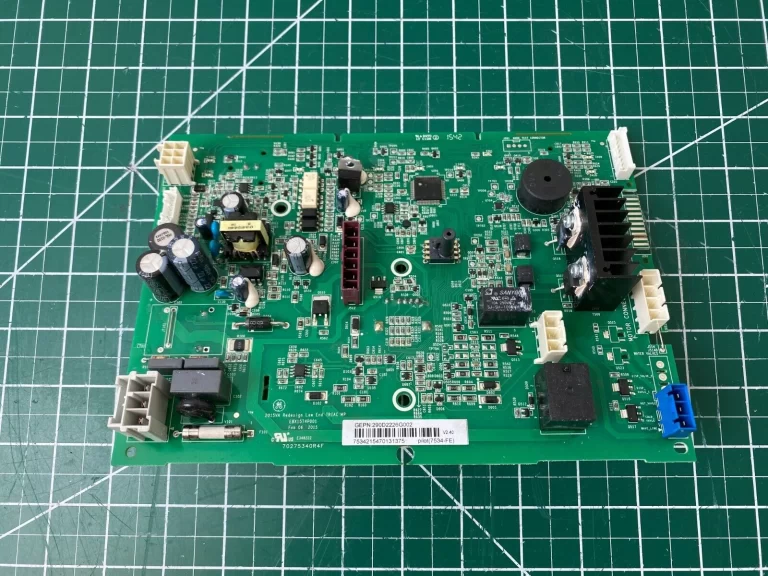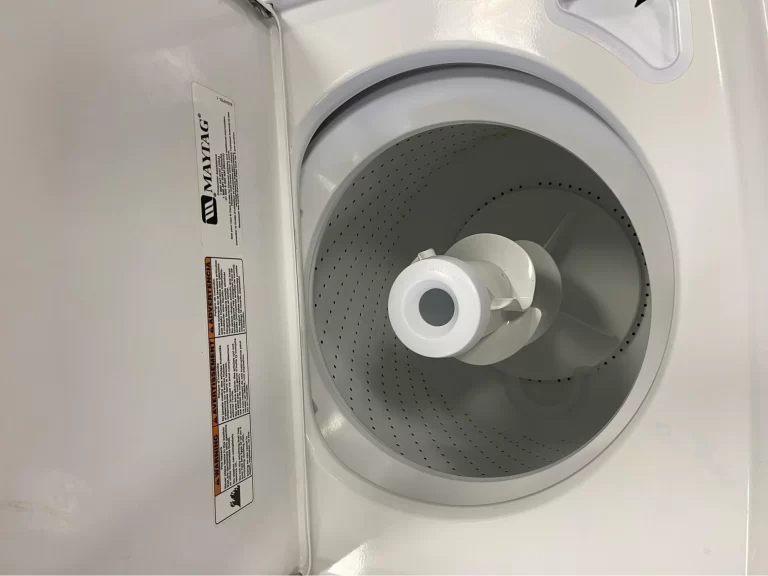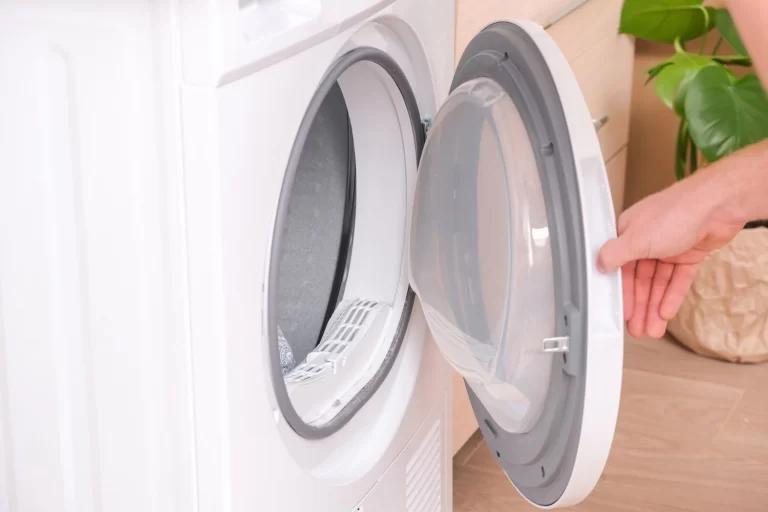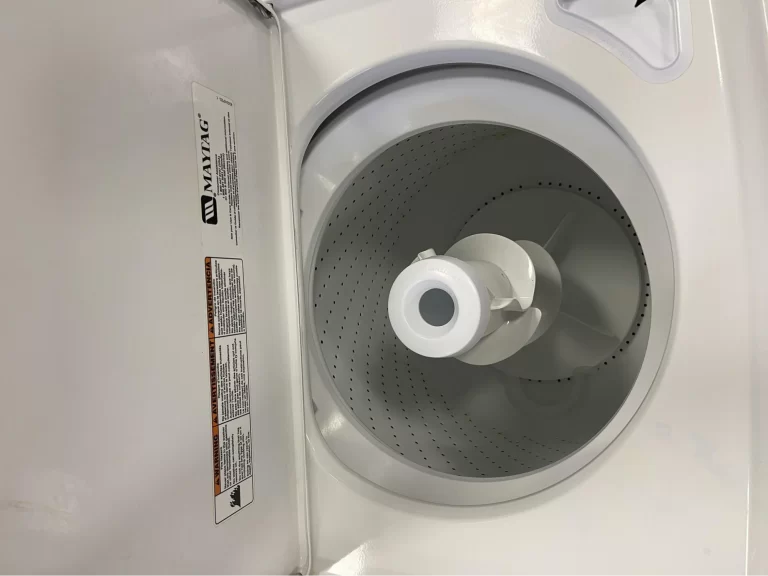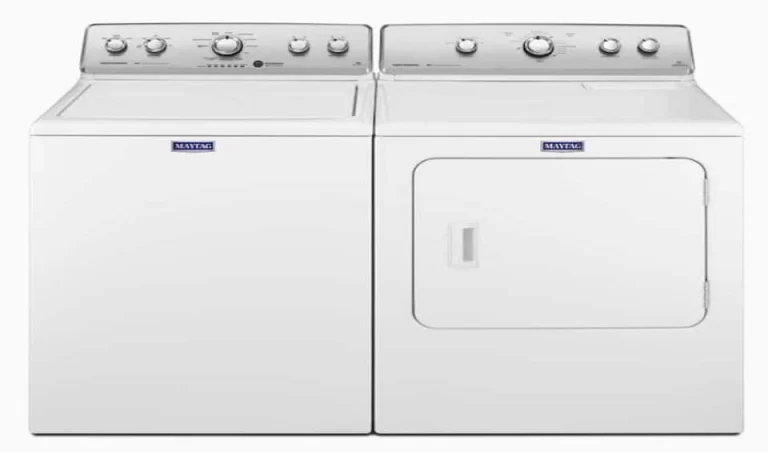Is your Amana washer failing to spin your clothes dry, leaving you frustrated and wondering what went wrong? Look no further! In this comprehensive guide, we will unlock the secrets to troubleshooting and resolving the common issue of an Amana washer not spinning clothes dry.
From diagnosing the underlying causes to step-by-step solutions, we will equip you with the knowledge and techniques needed to restore optimal performance to your washer. Say goodbye to damp laundry as we delve into the world of Amana washer repairs!
When an Amana washer fails to spin clothes dry, it can be due to several reasons such as drainage issues, a worn-out drive belt, problems with the door lock mechanism, a malfunctioning motor control board, or a damaged transmission. Diagnosing and addressing these issues can help resolve the problem.
Quick Troubleshooting Guide
| Issue | Symptoms | Fixes |
| Drainage issues | Clothes remain soaking wet after cycle | – Unclog drain hose or pump <br> – Remove blockages |
| Drive belt wear/damage | Drum not spinning properly or at all | – Replace worn-out drive belt |
| Door lock mechanism problem | Washer doesn’t lock properly, preventing spin cycle | – Clean, adjust, or replace door lock mechanism |
| Motor control board issue | Spin cycle malfunctions, possible error codes | – Repair or replace motor control board |
| Damaged transmission | Noisy operation, drum not spinning, potential error codes | – Seek professional help for transmission repair/replacement |
| Unbalanced load | Excessive vibrations, drum not spinning evenly | – Pause and redistribute clothes evenly <br> – Reduce load size |
| Clogged drain hose or pump | Poor water drainage, potential error codes | – Unclog drain hose or pump |
| Faulty lid switch | Washer not operating when the lid is open, potential error codes | – Repair or replace faulty lid switch |
| Motor coupling issues | No agitation or spinning, potential error codes | – Inspect and replace motor coupling |
| Faulty timer | Cycle not progressing or completing, potential error codes | – Repair or replace faulty timer |
| Motor brushes wear/damage | Drum not spinning, potential error codes | – Check and replace worn-out motor brushes |
| Suspension rods or springs | Imbalanced load, excessive vibrations | – Inspect and replace faulty suspension rods or springs |
Understanding Amana Washer Spin Cycle Issues
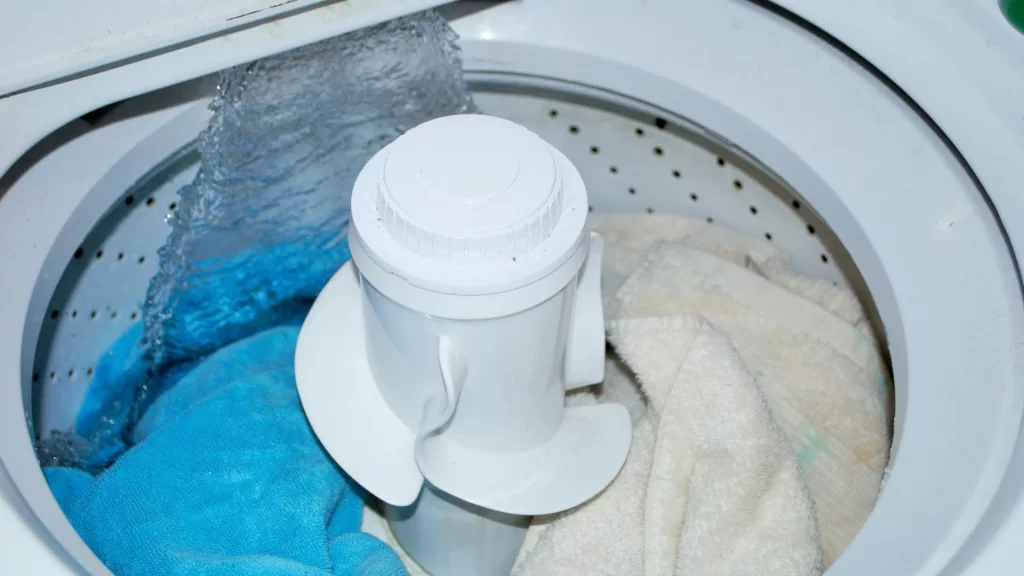
Before diving into the nitty-gritty of repairs, it’s crucial to understand the symptoms and causes of spin cycle problems in Amana washers. The most obvious symptom is when your clothes come out of the machine still soaking wet, even after the cycle has been completed. Other symptoms may include unusual noises during the spin cycle, the washer not reaching full spin speed, or the cycle ending prematurely.
So, what causes these issues? There can be a number of factors, but the most common culprits are:
- Drainage issues such as a blocked drain hose or pump
- A broken or worn-out drive belt
- Problems with the door lock mechanism
- A malfunctioning motor control board
- Damaged transmission
DIY Amana Washer Repair: Identifying Issues
When it comes to troubleshooting and repairing your Amana washer, identifying the underlying issues is a crucial first step. By understanding the symptoms and potential causes, you can effectively diagnose and resolve the problems. Here’s an expanded guide on how to identify common issues in your Amana washer:
1. Checking for Error Codes
Amana washers are equipped with error code systems that provide valuable information about specific malfunctions. Refer to your Amana washing machine user guide to understand the meaning behind these error codes. When an error code appears on the display panel, take note of it as it can give you valuable insights into the problem at hand.
2. Manual Inspection of Key Amana Washer Parts
Performing a visual inspection of critical components can often reveal obvious signs of wear, damage, or malfunction. Here are the key parts to inspect:
Drain Hose and Pump: Examine the drain hose for any kinks, clogs, or blockages that may hinder proper water drainage. Inspect the pump for any debris that may be obstructing its functionality.
Drive Belt: Check the drive belt for signs of wear, such as fraying or cracks. A worn-out or damaged drive belt can prevent the drum from spinning effectively.
Door Lock Mechanism: Ensure that the door lock mechanism is intact and properly aligned. A faulty or misaligned door lock can result in the washer not spinning.
Motor Control Board: Inspect the motor control board for any visible signs of damage or burned-out components. Malfunctions in the motor control board can disrupt the spin cycle.
3. Using a Multimeter to Check Electrical Components
For diagnosing electrical issues, using a multimeter can be helpful. Before proceeding with any electrical checks, ensure the washer is unplugged and follow proper safety precautions. Here’s how to use a multimeter:
Select the appropriate setting on the multimeter to measure resistance or continuity.
Test the continuity of electrical components such as the door lock switch, motor, or other relevant parts.
Compare the readings with the manufacturer’s specifications to determine if any components are faulty or require replacement.
By thoroughly inspecting and testing these key components, you can pinpoint the root causes of your Amana washer’s spin cycle problems. Identifying the issues accurately will allow you to proceed with the appropriate repairs or replacements, increasing the chances of restoring your Amana washer’s functionality and ensuring your clothes come out dry and ready to wear.
Step-by-Step Solutions to Amana Washer Issues
1. Unclogging a blocked drain hose or pump
Drainage issues often lead to the washer not spinning clothes dry, as the waterlogged clothes add too much weight for the drum to spin effectively.
To unclog a drain hose or pump, follow these steps:
- Turn off and unplug the washing machine for safety.
- Locate the drain hose at the back of the washer. It’s typically a flexible plastic or rubber tube.
- Using a bucket, disconnect the drain hose and drain any remaining water.
- Inspect the hose and pump for any visible blockages and remove them.
- If a blockage is deep inside, you might need a plumber’s snake or a long, flexible brush to reach it.
- Reconnect everything and run a test cycle to ensure the water drains properly.
2. Replacing a worn-out drive belt
If your washer’s drum isn’t spinning properly, the drive belt might be the issue. A worn-out or broken belt cannot efficiently transfer the motor’s spin to the drum.
Here’s how to replace it:
- Ensure the washer is turned off and unplugged.
- Remove the back panel of the washer to expose the drive belt.
- Take off the old belt by slowly rotating the pulley and pulling the belt off.
- Compare the old belt with the new one to ensure they are the same size.
- Fit the new belt around the motor pulley, then around the drum pulley. It may be tight, but that’s normal.
- Spin the drum pulley slowly to align the belt correctly.
- Replace the back panel, plug in the washer, and run a test cycle to confirm it’s working properly.
3. Repairing the door lock mechanism
The door lock mechanism ensures the washer doesn’t operate when the door is open. If it’s malfunctioning, the machine may not spin.
To fix this issue:
- Make sure the washer is unplugged before starting.
- Locate the door latch, usually found on the inside lip where the door closes onto the machine.
- Inspect the latch for any visible damage. If it’s bent or broken, it will need replacing.
- If there’s no obvious damage, check the alignment. If the latch isn’t aligning with the strike plate, the door won’t lock properly. Adjust as necessary.
- Check the wiring that connects the door latch to the control board. If it’s frayed or damaged, it may need to be replaced.
- If the latch is still not working, it’s best to call a professional as the issue could be with the control board.
4. Addressing motor control board problems
This is the heart of your washer, controlling all its functions. If it’s malfunctioning, it could cause the washer not to spin.
Unfortunately, motor control boards are complex and generally not user-serviceable. If you’ve diagnosed a problem with this component, it’s strongly recommended that you hire a professional to repair or replace it.
5. Transmission issues
If your washer is showing signs of a transmission problem, such as noisy operation or not spinning at all, it’s time to call a professional. Transmission repairs involve dealing with heavy components and can be complex, and typically require specific tools and knowledge.
Remember, these steps should always be done with safety in mind. If you ever feel unsure or uncomfortable performing these tasks, it’s always best to call a professional to avoid damaging your appliance or causing personal injury.
6. Dealing with an unbalanced load
An unbalanced load is one of the most common reasons for a washer not spinning clothes dry. This can happen when the clothes inside the drum are not evenly distributed, creating an imbalance when the drum spins.
To address this, follow these steps:
- Pause the washer and wait for the drum to stop spinning.
- Open the washer and manually redistribute the clothes more evenly.
- Close the washer and resume the cycle.
- If the problem persists, reduce the size of your laundry loads. Overloading the machine is a common cause of imbalance.
7. Troubleshooting a malfunctioning lid switch
The lid switch signals to your washer that the lid is closed properly. If it’s faulty, the washer may not spin.
To troubleshoot this:
- Ensure the washer is unplugged.
- Locate the lid switch, typically found near the lid hinge.
- Press the switch manually. If you don’t hear a clicking sound, the switch might be broken.
- If you’re comfortable with it, you can remove the switch and test it with a multimeter. If it doesn’t have continuity, it will need to be replaced.
- Replace the lid switch if necessary, or contact a professional if you’re unsure.
8. Resolving motor coupling issues
The motor coupling connects the motor to the transmission. If it’s broken, the washer may fill with water but won’t agitate or spin.
Here’s how to resolve this issue:
- Unplug the washer and remove the cabinet to expose the motor and transmission.
- Inspect the motor coupling to see if it’s broken or worn out.
- If the coupling is damaged, remove the old one and replace it with a new coupling.
- Reassemble the washer and test it to see if the issue is resolved.
- If you’re uncomfortable with this procedure, it’s best to call a professional.
9. Addressing a faulty timer
The timer controls many of the washer’s operations, including the spin cycle. A faulty timer could result in the washer not spinning clothes dry.
To fix a faulty timer:
- Unplug the washer for safety.
- Locate the timer on the control panel.
- Inspect the timer for signs of wear, burns, or other damage.
- Use a multimeter to test the timer for continuity.
- If the timer is faulty, replace it with a new one.
- If you’re unsure about this process, consider calling a professional.
10. Cleaning or replacing the water pump
If the water pump is clogged or faulty, it can cause drainage issues and prevent the washer from spinning properly.
To clean or replace the water pump:
- Unplug the washer and locate the water pump, typically at the bottom of the machine.
- Disconnect the pump from the drain hoses and inspect it for any clogs or debris.
- Clean out any obstructions and ensure the impeller spins freely.
- If the pump is damaged or the impeller doesn’t spin properly, replace the water pump with a new one.
- Reconnect the pump, plug in the washer, and test it to ensure proper drainage and spinning.
11. Checking the motor brushes
Over time, the motor brushes in your Amana washer may wear out, affecting the spinning performance.
To check and replace the motor brushes:
- Unplug the washer and access the motor assembly.
- Locate the motor brushes, which are usually situated near the motor housing.
- Inspect the brushes for wear or damage. If they are significantly worn down or have damaged bristles, they should be replaced.
- Remove the old brushes and replace them with new ones that are compatible with your Amana washer model.
- Reassemble the washer, plug it in, and test the spin cycle to see if the issue is resolved.
12. Inspecting the suspension rods or springs
If the suspension rods or springs that support the drum become loose or broken, it can result in an imbalanced load and hinder the spin cycle.
To inspect and replace suspension rods or springs:
- Unplug the washer and access the suspension rods or springs, typically located at the top or bottom of the drum.
- Inspect them for any signs of damage, such as visible cracks or breakage.
- If any rods or springs are faulty, remove them and replace them with new ones.
- Reassemble the washer, plug it in, and run a test cycle to ensure the drum spins smoothly without imbalance.
Preventing Amana Washer Spin Cycle Problems: Maintenance and Best Practices

An ounce of prevention is worth a pound of cure. Regular maintenance and correct usage of your Amana washer can prevent many common issues.
Make sure you’re not overloading the machine, as this can cause strain on various components and lead to problems over time. Clean the machine regularly, paying special attention to the drain hose, pump, and door seal. Also, consider using a surge protector to protect the washer’s electronic components from power surges.
Even with the best maintenance, some issues may require professional help. Don’t hesitate to contact a professional if you’re unsure about any aspect of washer repair. It’s better to be safe than sorry when dealing with electrical appliances.
FAQs
Why is my Amana washer not spinning clothes dry even though the drum is spinning?
If your Amana washer’s drum is spinning but the clothes remain wet, it could indicate drainage issues or a malfunctioning motor control board. Check the drain hose and pump for blockages, and ensure they are clear. If the drainage system is functioning properly, the issue may lie with the motor control board, which regulates the spin cycle. In such cases, professional assistance may be required to repair or replace the motor control board.
Can I fix a clogged drain hose myself, or do I need professional help?
In many cases, a clogged drain hose can be addressed by homeowners themselves. Start by unplugging the washer and locating the drain hose. Check for any visible blockages and remove them if possible. If the blockage is deep inside the hose or pump, you may need to use a plumber’s snake or a long, flexible brush to clear it. However, if you are unsure or uncomfortable dealing with plumbing or drainage issues, it is always best to seek professional assistance.
How do I know if the drive belt needs to be replaced in my Amana washer?
To determine if the drive belt needs to be replaced, inspect it visually. Look for signs of wear such as fraying, cracks, or a loose fit. If you notice any of these signs, it is likely that the drive belt is worn out and needs replacement. A faulty drive belt can cause the drum to spin inadequately or not at all, leading to clothes not being spun dry.
Is it safe for me to inspect the motor control board myself?
Inspecting the motor control board involves dealing with electrical components, which can be potentially dangerous if proper safety precautions are not followed. Before attempting any inspection, make sure the washer is unplugged. If you have experience and knowledge in handling electrical components safely, you can proceed with caution. However, if you are unsure or uncomfortable, it is advisable to seek professional help to avoid any risks or hazards.
What are the best practices to prevent spin cycle problems in my Amana washer?
To prevent spin cycle problems in your Amana washer, follow these best practices:
- Avoid overloading the washer, as it can cause strain on the components and affect the spin cycle.
- Perform regular maintenance, such as cleaning the drum, checking and cleaning the drain hose, and ensuring proper alignment of the door lock mechanism.
- Use surge protectors to safeguard the washer’s electronic components from power surges.
- Follow the manufacturer’s guidelines and recommendations for detergent usage and cycle selection.
- If you notice any unusual noises or issues during the spin cycle, address them promptly to prevent further damage.
Conclusion
While dealing with an Amana washer not spinning clothes dry can be frustrating, understanding the common causes and solutions can help you get your machine back in working order. Regular maintenance and correct usage can prevent many of these issues from occurring in the first place. Don’t forget, when in doubt, always consult with a professional to ensure the longevity and safe operation of your Amana washer.

